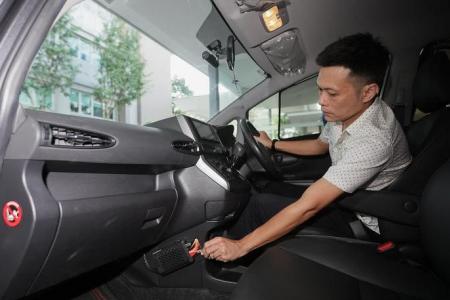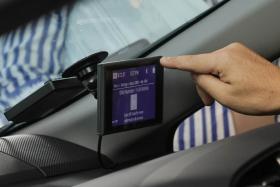Next-gen ERP on-board units to be installed from Nov; motorists can opt out of touchscreen display
On-board units for a satellite-based Electronic Road Pricing (ERP) system will be installed in vehicles in phases from Nov 1 this year, and is expected to be concluded by the end of 2025.
In all, nearly one million vehicles will be fitted with new on-board units (OBU), starting in November with about 20,000 fleet vehicles – those registered to a company or organisation.
The devices will be installed on new vehicles from the first quarter of 2024, while all other existing vehicles will be scheduled in batches, based on the vehicle’s age.
In a nod to feedback from the public that the OBU is too bulky, the Land Transport Authority (LTA) on Monday said motorists can opt out of installing the touchscreen display and get key information via mobile apps on their smartphones instead.
The new OBU that replaces the current in-vehicle unit has three pieces – a processing unit located on the side of the front passenger footwell, an antenna and a touchscreen display mounted on the windscreen. Motorcycles will have a single-piece unit mounted on the handlebar.
Vehicle owners will be notified by LTA when it is their turn to install the OBU, with instructions on how to schedule an appointment.
The OBU will be free if installed within the two-month period stated in the notification, said LTA, adding that it will announce more details about the installation for individual vehicles early next year.
The next-generation ERP system will replace the current 25-year-old cordon-based system, which LTA said is reaching the end of its operational lifespan.

Installation works were pushed back twice – the exercise was supposed to start by the end of 2020, but got delayed to 2021 due to a global semiconductor shortage arising from the Covid-19 pandemic. It will now start from Nov 1.
While the satellite-based system can support distance-based charging, LTA said it has “no immediate plans” to start charging motorists based on the distances they clock.
There will be no change to how motorists are currently charged during the transition period, LTA said, without elaborating on how long this would be. ERP gantries will be gradually removed after the installation period, and LTA is looking into visual markers or signs to clearly indicate ERP charging locations.
The new OBU is compatible with the current ERP systems and carparks.

The LTA said the OBU touchscreen display will provide motorists with information such as ERP locations and charges, their card balance, traffic updates and the locations of silver zones, school zones, speed cameras and bus lanes.
After all vehicles are equipped with the new OBU, there will be additional features such as payment of roadside parking and real-time traffic alerts to inform motorists of road closures, accidents or heavy traffic.
“Motorists are strongly encouraged to install all three OBU components to access the full range of features, such as paying for roadside parking,” said the LTA.

To cater to those who want to use their smartphones to access ERP information, the LTA said it has released a software development kit to allow developers to create mobile apps that integrate and display key ERP data, such as charging and traffic information.
There are strict security safeguards, such as ensuring that apps can receive only ERP information from the OBU but not read other data or make any changes to the data, LTA said.

On why the new ERP system cannot be completely replaced with a smartphone-based payment system, LTA said the OBU has been designed with more robust security measures, and was tested extensively to ensure it could handle real-time charging transactions and data securely.
The OBU also eliminates other operational issues with a smartphone-based system such as ensuring the mobile app is working and that the phone has enough power and is connected to the cellular network through the drive, LTA added.
Get The New Paper on your phone with the free TNP app. Download from the Apple App Store or Google Play Store now


